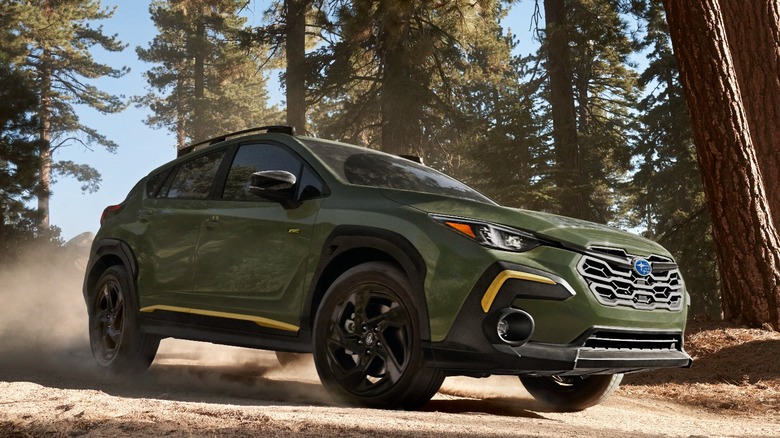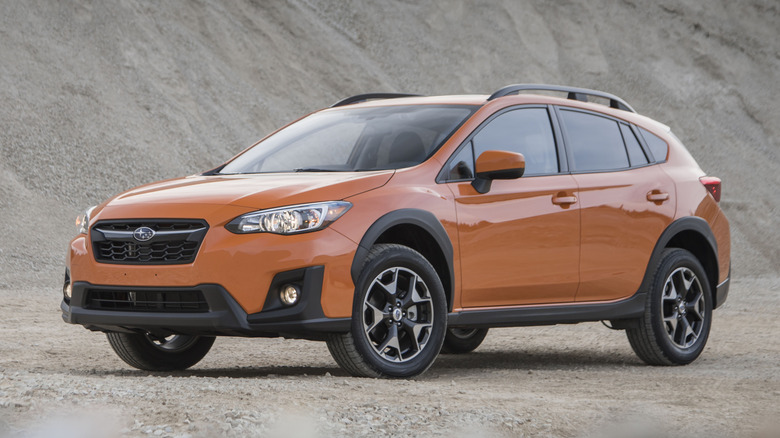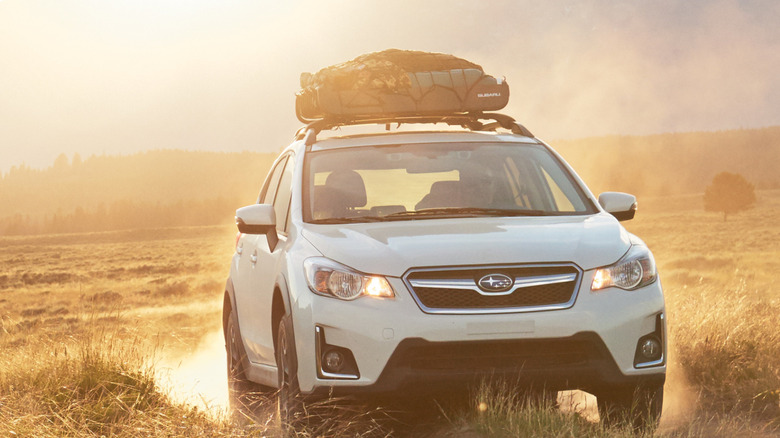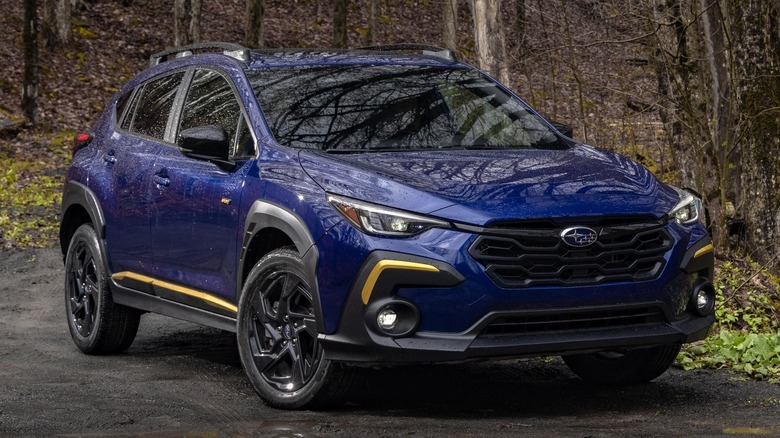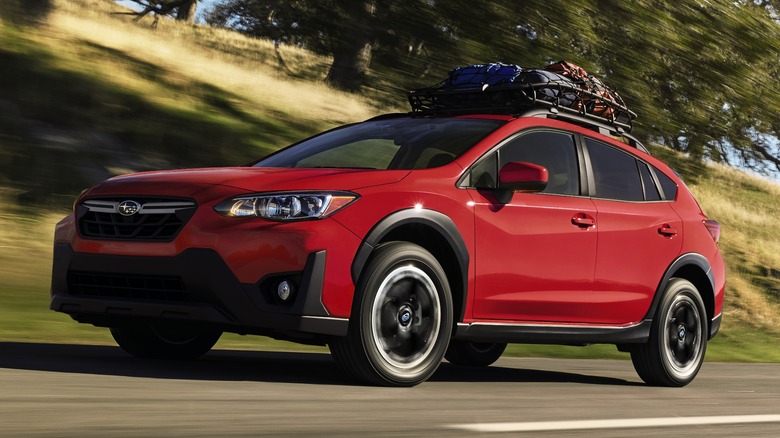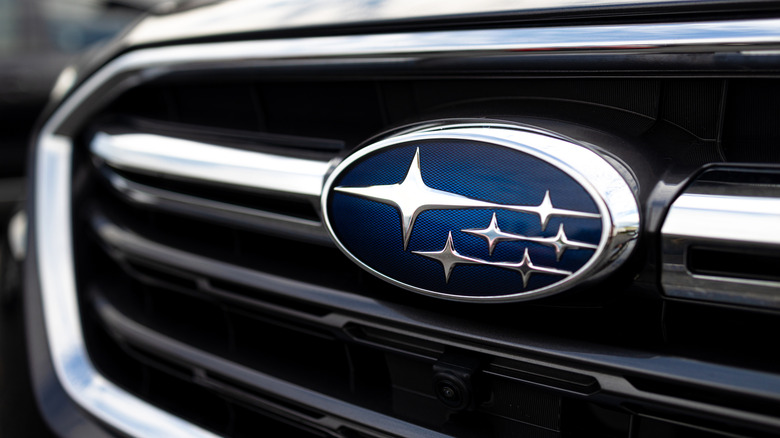Every Generation Subaru Crosstrek, Ranked Least To Most Reliable (According To Owners)
When Subaru launched the 2013 XV Crosstrek in the U.S., few would have expected the compact crossover to become one of the company's best- and fastest-selling vehicles. But that's precisely what happened, with XV Crosstrek sales climbing year-on-year from the get-go and breaking past the 100,000-unit milestone in 2017 — despite somewhat weedy performance from its otherwise reliable 2.0-liter boxer engine.
Subaru dropped the XV in 2016, with the model known from then on just as the Crosstrek. But while the name changed, the concept remained the same: a compact SUV with four-wheel-drive and extra ground clearance at home on city streets or tougher mountain trails. Not that there was any reason to shake things up too drastically: The company nailed the formula the first time around, with successive generations — including the newest third-generation offering — more about refining its execution than anything else.
Even the oldest Crosstrek is still only about 10 years old, so it's perhaps a bit too soon to make any definitive judgments about the reliability of each Crosstrek generation. That said, as with any vehicle, it's possible to pinpoint some areas of concern for the Crosstreks based on owner complaints, cross-checking those hosted on the NHTSA website with forum and Reddit posts. So, whether you're thinking of buying a used Crosstrek or are just wondering where yours ranks in the nameplate's — relatively short — lifetime, this list is for you.
4. Second generation pre-facelift (2018 - 2020)
Subaru's second-generation Crosstrek debuted for the 2018 model year, becoming the company's second vehicle to use its Subaru Global Platform after the 2017 Impreza. The second generation Crosstrek brought with it a range of improvements to the SUV, with a more spacious interior, more standard features, and an updated version of Subaru's signature four-cylinder boxer engine with slightly more power (152 hp versus 148 hp).
The most common mechanical complaint for the late-2010s Crosstrek — on the NHTSA website, forums, and Reddit — seems to be excessive battery drain. Some owners had their batteries die regularly, and we've seen reports claiming that their Crosstreks died simply from being left overnight. Thankfully there seem to be a few ways around this, with owners sharing a range of fixes for the issue. These range from invasive methods such as modifying the charging system or disabling the Data Communication Module (DCM) to mundane solutions like installing third-party batteries like an ACDelco Gold AGM unit. Beyond that, the other big issue is one that many newer Subarus have: a fragile windshield.
We've also spotted reports of a blown engine or two, but it seems rare and — in one case, at least — directly attributable to oil starvation, so we don't think it's a particular cause for concern. There are also sporadic complaints of unintended acceleration for the first two years of this generation, despite the Crosstrek not usually mentioned in reports of this alleged fault. Despite that, our overall impression is that owners love how reliable their second-gen Crosstreks generally are. Cracked windshields aside, that is.
3. First generation (2013 - 2017)
The Crosstrek debuted in 2013 as the XV Crosstrek, with Subaru of America highlighting its fuel efficiency and light offroad capabilities thanks to its all-wheel drive and 8.7 inches of ground clearance. It proved a hit with the buying public, too. More than 50,000 made their way to driveways across the country in its debut year.
Subaru's new SUV was also home to its then-new FB20 engine, which the company had announced earlier in 2010. The new FB engine brought with it welcome improvements such as better fuel efficiency and reduced weight, the introduction of new technology rarely goes off without a hitch, and that was the case for the FB engine. Enthusiasts point out that 2012 to 2014 FBs had oil burning issues, and complaints on the NHTSA website seem to back that up, with a handful of oil consumption-related complaints popping up in the first few years. The 2013 Crosstrek in particular is a Subaru model to avoid, with a failure-prone valve spring which didn't help the oil burning issues. Subaru issued a recall, but some owners allege that the recall led to more engine issues in turn.
Beyond those first few years, the first-generation Crosstreks seem reliable according to those who own them. Some wheel bearings will need replacing, and other components suffer from wear and tear, but that's nothing out of the ordinary. Battery drain woes started creeping in from 2016 — coinciding with Subaru's introduction of the DCM-powered Starlink security system — so that's something to keep an eye out for.
2. Third generation (2024 onward)
Subaru debuted the all-new third-generation Crosstrek at the 2023 Chicago Auto Show, emphasizing the updated compact SUV's new design, stiffer chassis, and handling improvements — the latter courtesy of the WRX's dual-pinion electronic power steering, new on the 2024 model.
We don't think there's any way of accurately judging the newest Crosstrek's reliability until it's gotten a few more years under its belt. Some commenters point to American assembly on the 2.5-liter models being a downside, but we're unsure if there's objective data behind this. Some owners have had problems with the fit and finish on their U.S.-built 2.5-liter Crosstreks, so there seem to be some teething problems involved with the change in the Crosstrek's assembly plant. Are these quality assurance issues a portent of more serious mechanical woes to come? Only time will tell.
If you're considering buying a new Crosstrek, you may want to wait and see whether Subaru of America can iron out some of these kinks. Fit and finish aside, though, the 2024 Crosstrek seems like another solid iteration of the best-seller SUV; our own Steven Ewing reviewed the 2.5-liter Sport and praised the improved performance and better driving experience compared to previous generations.
1. Second generation facelift (2021 - 2023)
Thankfully for Subaru, the second-generation Crosstrek's reliability seemed to improve significantly after a mid-cycle refresh in 2021. Admittedly, these are also still very new, and it'll likely take a few more years for any major reliability headaches to rear their heads, but all signs so far point to these newer Crosstreks earning their place as one of Subaru's most reliable models.
Crosstreks generally get a lot of love, but this stretch seems to be a bigger hit with owners. It's not hard to find 2021 to 2023 Crosstrek drivers praising their SUVs' general reliability and good fuel economy, with some attributing this to the fact that all 2023 model-year Crosstreks were built in Japan. The NHTSA website echoes these owner reports, with few mechanical complaints logged during these three model years.
But this doesn't mean that these Crosstreks are wholly trouble-free. Subaru's seemingly persistent woes with fragile, easily cracked windshields — also present on recent Subaru Outback generations — continue unabated here, with many complaints on the NHTSA website highlighting — sometimes spontaneous — windshield cracks. One Crosstrek owner had to replace their 2021 Crosstrek's windshield three times within 9,000 miles, which shouldn't be happening. It's not necessarily the end of the world, especially if your auto insurance covers windshield replacements, but it's still far from ideal on a new vehicle. The question of whether crack-prone windshields are a reliability issue is one we'll leave for you to decide.
Our methodology
We based our ranking of Subaru Crosstrek generations primarily on owner complaints, with the primary sources being those posted on the NHTSA website — which logs customer complaints, recalls, and manufacturer communications per model year — cross-referenced with posts on public forums. The goal was to ensure that the problems we highlight are indeed representative of each generation and not simply outliers. This isn't a perfect way to evaluate reliability, but its helpful for identifying patterns and specific failure-prone aspects of a given vehicle.
The nature of the complaints also played a role in our ranking; repeated battery drain issues are a bigger problem than delaminating head units, for example, as unsightly and frustrating as the latter can be. We also consider replacements for wear and tear components such as bushings and wheel bearings to be part and parcel of maintaining a car, so these didn't factor into our considerations — although many Crosstrek model years are probably still too new to have to replace these parts.
We opted not to emphasize recalls too heavily for this list given that these can differ greatly between model years, with no generation-spanning recalls so far in the Crosstrek's lifetime. But it's still worth mentioning that you should check the recall history for any used vehicle your considering, Crosstrek or otherwise, and make sure that the previous owner(s) sent the car in if the VIN was part of a recall campaign.
